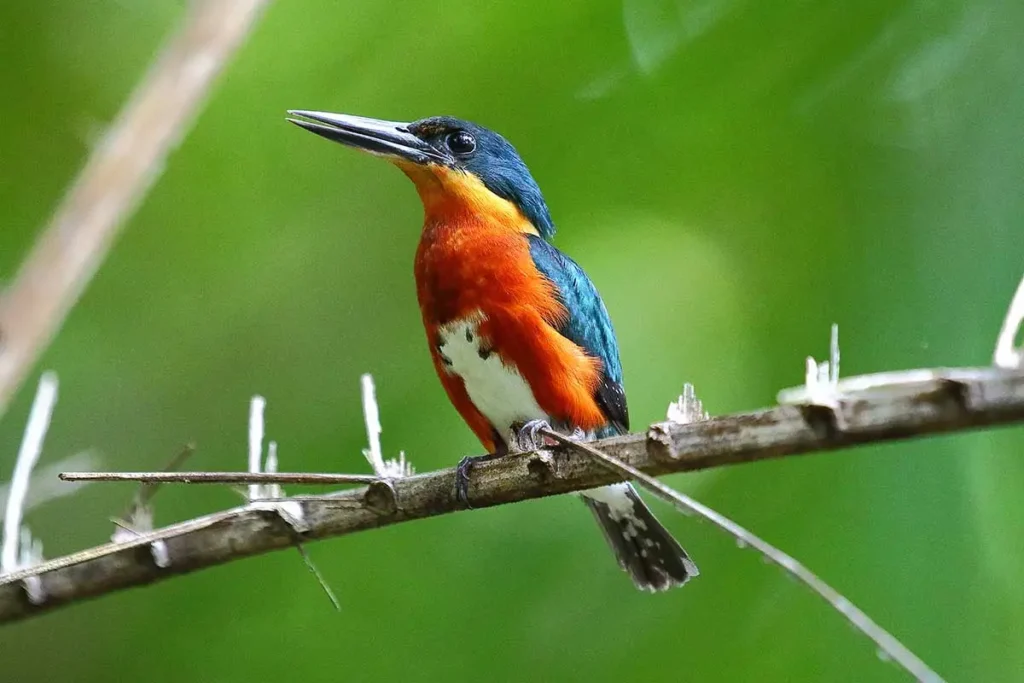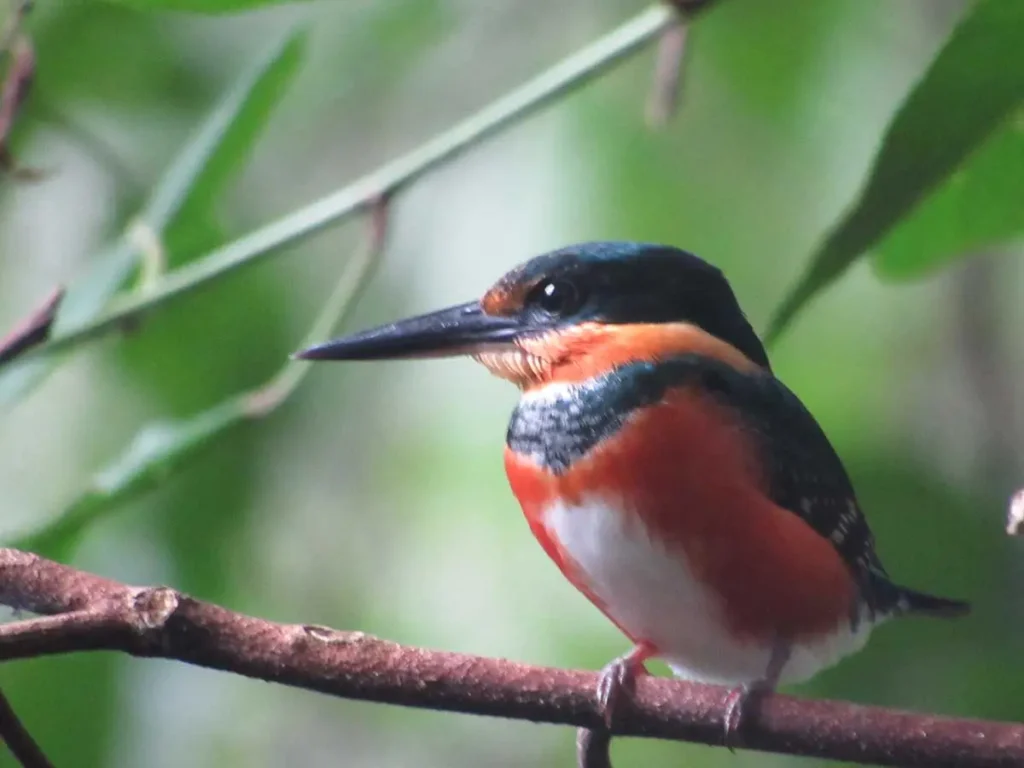
The American Pygmy Kingfisher (Chloroceryle aenea is its scientific name) is a fascinating bird species found in the dense forests of Central and South America. Belonging to the family of Alcedinidae, this very small kingfisher is known for its striking appearance and agile hunting abilities. In this article, we will explore the captivating world of this remarkable bird.
Physical Characteristics
Size and Weight
The American Pygmy Kingfisher, like the hummingbirds, is a small bird, with a body length of about 5 inches and a weight of just 18 grams. Its small size allows it to maneuver easily through the thick vegetation of its habitat.
Coloration and Markings
The American Pygmy Kingfisher sports a dark blue crown, a white ear patch, and rufous underparts. The wings and tail exhibit blue and black markings, while the white and brown markings on the ear coverts distinguish it from other similar species. The bird’s beak is an eye-catching orange color.
Differences between both sexes
Males and females are similar in appearance, but there are some subtle differences between sexes. The adult males have a blue spot on their lower belly, while adult females have a brown spot. Additionally, adult males have a less extensive violet wash on their ear coverts than females.

Habitat and Distribution
Preferred Habitats
The American Pygmy Kingfisher prefers woodlands near slow-moving or stagnant water sources. It can be found in areas with low perches, which it uses to scan for prey. The bird is also known to inhabit sandy soil banks and ground termite nests.
Range and Distribution
This bird species is distributed widely across Central and South America, with its range extending from southern Mexico and south to western Panama and northern South America. It is a common resident in its preferred habitats.
Diet and Hunting Behavior
Typical Prey Items
The American Pygmy Kingfisher feeds on a diverse diet, including small frogs, insects, spiders, lizards, and even occasionally small crabs. They are also known to consume praying mantises, which are usually avoided by other bird species due to their aggressive nature.
Hunting Techniques
The American Pygmy Kingfisher hunts from low perches, using its keen eyesight to spot its prey. Once it locates a target, it swiftly dives into the water or onto the ground to capture it. The bird’s small size and agile flight make it an effective predator in its woodland habitat.

Breeding and Reproduction
Nesting Sites
The American Pygmy Kingfisher often nests in sandy soil banks or ground termite nests. The birds excavate a burrow, which can be several feet long, leading to a chamber where they lay their eggs. These nesting sites provide a safe and secluded space for the birds to raise their young.
Mating and Breeding
During the breeding season, which varies depending on the region, the male American Pygmy Kingfisher performs an elaborate courtship display to attract a mate. Once a pair has formed, they work together to excavate their nesting burrow.
Egg Incubation and Chick Rearing
The female American Pygmy Kingfisher typically lays a clutch of three to six white eggs. Both parents care for the eggs, taking turns incubating them for around 17 to 20 days. After the chicks hatch, the parents continue to provide for their young, bringing them a steady supply of insects and other small prey. The chicks fledge after about 20 days and may remain with their parents for a short time before becoming independent.

Vocalizations and Communication
Distinctive Calls
The American Pygmy Kingfisher has a high-pitched, insect-like call, which it uses to communicate with other members of its species. The call is often described as a rapid series of “tik-tik-tik” or “pee-pee-pee” notes. These vocalizations help the birds maintain contact with their mates or signal their presence to rivals.
Communication through Posture
In addition to vocalizations, the American Pygmy Kingfisher communicates through body language and postures. For example, during courtship displays, the male will often raise its dark blue crown and fan its tail feathers to impress the female. These visual cues help reinforce the pair bond and play a vital role in successful breeding.
Comparison with African Pygmy Kingfisher
The African Pygmy Kingfisher (Ispidina picta) is another small kingfisher species found in southern Africa, including the drier western regions. It shares some similarities with the American Pygmy Kingfisher, such as its small size and preference for woodlands. However, there are notable differences in appearance and behavior.
For instance, the African Pygmy Kingfisher has a violet wash on its ear coverts and a black agouti pattern on its back, while the American Pygmy Kingfisher has an orange bill, a white ear patch and blue and white markings on its wings and tail.
The African species also has a different diet, primarily feeding on insects like the high pitched insect-like prey, and occasionally small crabs, whereas the American species has a more varied diet that includes small frogs, lizards, and spiders.

Predators and Threats
Natural Predators
The American Pygmy Kingfisher, due to its size, is vulnerable to a variety of predators, including birds of prey, snakes, and mammals. Its bright coloration may serve as a warning to potential predators that it is a swift and agile target, its smaller size also making it difficult to catch. The bird’s preference for dense vegetation also provides it with cover from potential threats.
Human Impact
Human activities can pose a threat to the American Pygmy Kingfisher’s habitat. Deforestation, agriculture, and urbanization can lead to the loss of suitable nesting sites and prey resources. Although this bird species is currently not facing significant population declines, it is essential to continue monitoring and protecting its habitat to ensure its long-term survival.
Conservation Status
The American Pygmy Kingfisher is currently listed as a species of “Least Concern” on the IUCN Red List. This is due to its large range, stable population, and relatively low levels of habitat destruction within its preferred habitats. However, continued monitoring and conservation efforts are essential to ensure the long-term survival of this captivating bird species.
Interesting Facts
The American Pygmy Kingfisher is one of the smallest members of the kingfisher family, Alcedinidae.
Despite their name, American Pygmy Kingfishers are not closely related to the larger, more familiar kingfishers found in North America, such as the Belted Kingfisher.
These birds can hover briefly in the air before diving to catch their prey, displaying impressive aerial acrobatics.
The American Pygmy Kingfisher is a solitary species, typically found alone or in pairs, rather than in large flocks.
Unlike some other kingfisher species, the American Pygmy Kingfisher does not have a strong territorial instinct and can be found living in close proximity to others of its kind.

Final Thoughts: A Deeper Appreciation
The American Pygmy Kingfisher is a small yet remarkable bird that offers a unique glimpse into the diverse world of kingfishers. Its vivid colors, impressive hunting skills, and intriguing behavior make it a favorite among birdwatchers and nature lovers alike. By gaining a deeper understanding of this species and its needs, we can ensure that the American Pygmy Kingfisher continues to thrive in its natural habitat, delighting future generations with its enchanting presence.
